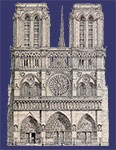
Church Notre Dame is a gothic cathedral dedicated to Virgin Mary. The story of this cathedral draws attention of numerous tourists, since it was constructed with discontent of the people, it was badly damaged during the French revolution and completely neglected afterwards, only to become one of the most well-known tourist attractions in the city.
Notre Dame is a gothic cathedral that apart from its original purpose is also an important tourist attraction of Paris. The cathedral is located on a natural river island in the River Seine. On the grounds where the cathedral stands today, once was located the temple of Jupiter which was constructed by Gaius Julius Caesar during his work on the reconstruction of Lutetia (the Roman name for the city). In 1160, Maurice de Sully became a new bishop of Paris who argued for the construction of a new cathedral, large enough to receive all worshipers. Therefore, it was decided that two nearby churches to be demolished in order for the new cathedral to be built, a cathedral dedicated to Virgin Mary which became known as Notre Dame. Pope Alexander III was present at the start of the construction works.
 The architecture of this cathedral is really unique- the structure is 130m long, 48m wide and 36m high, decorated with 2,230 statues in the gothic style. Since the construction of the cathedral was financed by the taxation of the local population, a large riot broke out against the clergy and the bishop in 1223. The conflict ended with the papal intervention and harsh punishments of the rioters-rebels. The construction works continued, but the building was finished only in 1345. During the French revolution the cathedral was sacked and damaged. All of the statues that once had adorned the façade of the church were demolished, while the bells of the church were melted for the production of arms. In 1793. A French politician and economic theorist Henri de Saint-Simon had the intention to buy the cathedral in order to completely demolish it. After Napoleon came to power the purchase contract was annulled. In 1801, Napoleon made peace with papacy and signed a treaty with Pope Pio VII. According to this treaty France acknowledged the Catholic religion as the dominant religion of the country while the church recognized the territories won by the revolution. Napoleon ordered additional decoration of the church for his coronation ceremony in 1804.
The architecture of this cathedral is really unique- the structure is 130m long, 48m wide and 36m high, decorated with 2,230 statues in the gothic style. Since the construction of the cathedral was financed by the taxation of the local population, a large riot broke out against the clergy and the bishop in 1223. The conflict ended with the papal intervention and harsh punishments of the rioters-rebels. The construction works continued, but the building was finished only in 1345. During the French revolution the cathedral was sacked and damaged. All of the statues that once had adorned the façade of the church were demolished, while the bells of the church were melted for the production of arms. In 1793. A French politician and economic theorist Henri de Saint-Simon had the intention to buy the cathedral in order to completely demolish it. After Napoleon came to power the purchase contract was annulled. In 1801, Napoleon made peace with papacy and signed a treaty with Pope Pio VII. According to this treaty France acknowledged the Catholic religion as the dominant religion of the country while the church recognized the territories won by the revolution. Napoleon ordered additional decoration of the church for his coronation ceremony in 1804.
Twenty five French kings were coroneted in the beautiful Notre Dame cathedral.
Numerous details are worth mentioning regarding Notre Dame: above the entrance door the image of the Judgment day was carved (according to the belief that at the end of the time all people will be judged - bad people will end up in hell while good people will gain an internal life), sculptures that represent the temptations of Adam and Eve, the gallery of kings (composed of 28 statues of kings, 3.5 meters high), and the incredible interior of the church decorated with three breathtaking windows covered with stained glass, large organs, numerous statues and art works.
In case you are interested in visiting terraces of the cathedral, on the left side, when facing the entrance to the church, you will find the stairs that lead to the top of the structure. Form these terraces you will enjoy a magnificent view on Paris.
Interesting facts